By Holli Cederholm
On Thalassa Raasch’s outstretched palm is a rainbow of pollen – yellow, orange, gray, green and even bright blue – reflecting the colors of the early spring blooms that honeybees have collected the grains from. It is a sunny, 60-degree day in April and Raasch, clad in coveralls and a floral-print neckerchief instead of the standard-issue beekeeper’s suit, is kneeling on a lawn behind the home of Governor Mills in Maine’s capital city of Augusta. “Taste one,” she says, offering me a grain of pollen, unphased by the thousands of honeybees flying by her unveiled head.
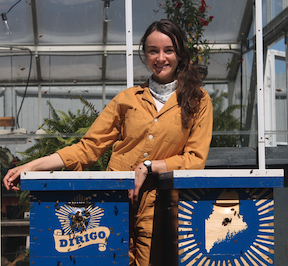
Raasch has been keeping honeybees for nearly a decade, but she is not your average apiarist. She is on a mission to build a community of support to help these important pollinators thrive. At 17, Raasch apprenticed on a commercial bee farm with 300 to 400 hives near Minneapolis, Minnesota. “I just fell in love,” she says. “Obviously bees are an integral part of our agricultural and food system, our ecosystems, as we’ve developed them post-colonization. But, for me, it’s also a fascination with the behavioral biology of this insect.”
Her innovative business, Keepers, based in Portland, Maine, combines sales of her bee products, including limited edition honey and beeswax taper candles, with educational offerings such as beekeeping workshops, a subscription newsletter, honey tastings and beehive tours (in which participants may also get the chance to sample pollen). Raasch’s main focus, however, is her unique take on beehive management services.
Hive management is not a new concept. Mobile hives of non-native honeybees for pollination services are standard in commercial agriculture, from blueberries and cranberries to melons and pumpkins, and due to their agricultural significance, the honeybee (Apis mellifera) was adopted as Maine’s state insect in 1975. However, Keepers’ beekeeping services are different than the mobile model: Clients own the bees and, while the insects fly 2 to 3 miles to forage for their floral food sources, the hives stay put. Raasch installs the hives and checks on them throughout the year – and from year to year – engaging each client in the process based on their interests. In this way, Raasch acts both as bee tender and a beekeeping guide.
“We bring the bees to you,” Keepers’ website explains alongside a client list that includes businesses, organizations and households located – with the exception of the Blaine House – in the greater Portland area.
Raasch explains that those interested in her hive management services are typically people with an interest in beekeeping as a hobby that do not want to tackle it alone. Honeybees, she is quick to note, are complex organisms. Each hive is home to a colony consisting of a family unit – a queen bee, worker bees and drone bees – that together form a superorganism that cannot survive without the distinct roles enacted by each type of bee. Learning honeybee biology, and the infrastructure and management practices necessary to support each life cycle, is critical to a healthy hive. Add to that an entire suite of new skills, like pest and disease identification and mitigation, swarm catching, and honey harvest and processing, and the learning curve for a beginner beekeeper starts to look pretty steep.
Others, like Keepers’ first clients Josh Berry and Matt Duley, chefs at the Press Hotel’s Union Restaurant in Portland, are motivated by a desire to support local ecology and see honeybees as a critical way to do so. In 2018 Raasch was working at The Honey Exchange, Portland’s local hub for beekeeping resources and supplies, when the two chefs walked in and presented the idea of putting hives on top of the hotel. Raasch helped them install a pair of hives on the hotel’s rooftop – 100 feet above the city sidewalk – in 2018, and added two more in 2019. The bees forage for pollen (their main source of protein), nectar (for carbohydrates), tree sap and resin (for building the inner architecture of their hives), and water all over the peninsula and, in doing so, provide the indispensable ecosystem service of plant pollination. According to Raasch, the bees’ range spans from their home in the city’s center out to Western Promenade Park to Deering Oaks Park to the Eastern Promenade and back to the Press Hotel – covering 12.5 to 28 square miles in total.
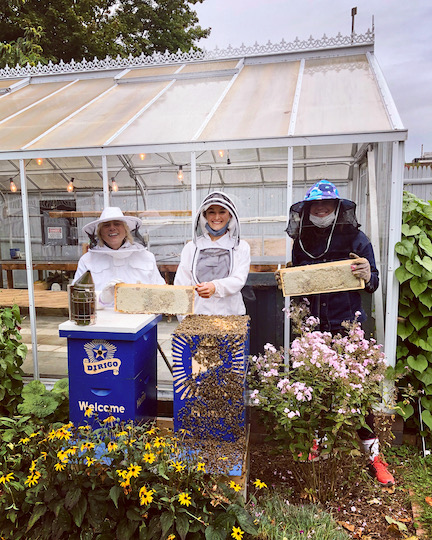
Governor Mills and Commissioner Judy Camuso of the Maine Department of Inland Fisheries and Wildlife – both the first women in Maine’s history to hold these positions – harvest honey at the Blaine House. Photo courtesy of Keepers
After the collaboration with the Press Hotel, her beekeeping services grew organically. She installed two hives at the Blaine House in 2019 upon the request of director Leslie Oster and grounds manager Jeff Futrell. One hive is emblazoned with Maine’s state motto, “Dirigo,” meaning “I lead.” Raasch says, “These hives lead the way for making space for the honeybee at our state capitol and set an example for the ways in which we can live peacefully alongside honeybees.”
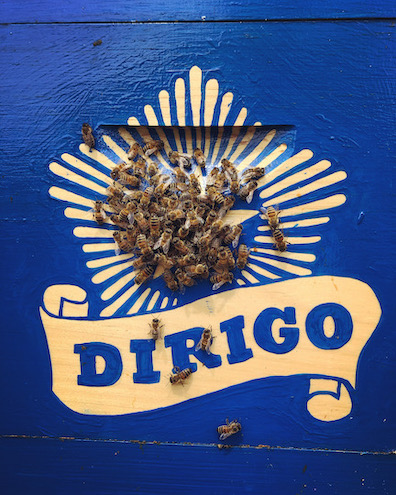
Maine’s state motto is stenciled on one of the beehives at Governor Mills’ residence. The hives at the Blaine House lead the way in celebrating the importance of the honeybee within the state. Photo courtesy of Keepers
The Blaine hives are entering their third summer situated between the governor’s heirloom apple orchard and flower gardens, which Oster said are now cultivated using organic practices. Raasch aims for a 100% survival rate for her customers’ hives, which is no easy feat given the challenges that bees are up against. In addition to Maine’s harsh winters, honeybees also face multiple compounding threats, including pesticide exposure, flowerless landscapes due to vast monocultures and, perhaps their most notorious foe, the parasitic mite aptly named Varroa destructor. Of the mite, Raasch says, “For comparison, it would be like we had a small Chihuahua latched onto us that we were always carrying around.”
She explains, like the proverbial canary in the coal mine, the honeybee is signaling the stressors present in our shared environment. “The health of the honeybee is directly linked to our own health, not just our food systems,” says Raasch.
Raasch likens her role of beekeeper to a doctor doing a checkup. She visits her clients’ hives about 20 times during the course of the year, monitoring bee health and working to create an optimized environment for the bees to do their job and hopefully make a little extra honey for the humans. “Different beekeepers have different approaches to this, but I’m really interested in learning as much as I can about what they would be doing naturally while recognizing that what I’m doing is artificial – kind of forcing them to live in these homes – but trying to use that information that I learned to make their lives as good as possible and kind of tap into those natural instincts and be aligned with that.”
Creating the ideal environment for honeybees is especially precarious when it comes to Maine’s winters. As outdoor temperatures dip below freezing, the honeybees cluster inside the hive and try to stay warm. “Winters are the hardest as a beekeeper. We’re holding our breath, hoping we did everything right to get our bees through,” says Raasch.
The bees don’t leave the hive when temperatures drop below 50 degrees. In Maine that means their flying days are severely limited between October and March, depending on the year and the hive’s location within the state. The first above-50-degree day in late winter or early spring is a reason to celebrate: the honeybees will leave the hives on a “cleansing flight” for the first time in months, littering the area around their hive with a sight that many a beekeeper could love. “Bee poop,” as Raasch calls it, is evidence that the colony has survived the winter.
On warm, sunny days thereafter, like the spring morning Raasch and I spent in the Blaine beeyard in Augusta, a healthy hive buzzes with activity. Some bees flew off to collect pollen – from crocus, pussy willow, silver maple and squill, the source of the rare blue pollen, Raasch tells me – while others returned carrying their scavenged pollen in baskets, like cargo pockets, on their hindlegs.
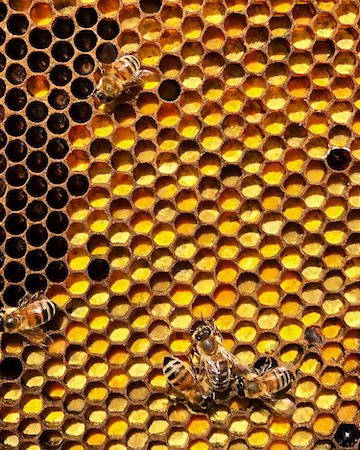
In the early spring, Raasch’s role as beekeeper is to observe each colony’s activity – checking on the queen and assessing mite levels, which she treats for when necessary with formic acid. Once the dandelions start to bloom in May, however, Raasch is on the lookout for signs that a colony might swarm. When swarming, the queen and a portion of the honeybees leave the hive in search of a new home. In this way, the colony replicates itself. “For them, casting the swarm is to spread their genetics and to be successful animals in the world,” says Raasch. While this sounds like a boon for bees, many honeybee emigres don’t survive on their own. A swarm is also a potential loss for apiarists, including Keepers’ clients. Raasch tries to stave off impending swarms with a proactive practice known as “splitting.”
Splitting is basically what it sounds like: a division of the hive. The wooden Langstroth beehives that Raasch favors are widely used across the country as the stackable design consisting of boxes (hive enclosures) and the frames within (for honeycomb and brood comb) allow for apiarists to customize the hive based on the needs of both the bees and the keeper. When performing spring splits, also known as artificial swarms, Raasch removes the queen, along with some frames of pollen and honey, and places them in a new 8-frame Langstroth – this act tricks the bees into thinking they’ve reproduced, thereby preventing the dreaded swarm.
Raasch also looks to splitting as a tool to multiply her hives in a sustainable way while building resilient honeybee colonies. Left without a queen, the bees in the original hive will rear a “daughter queen” from a larva produced from the initial colony of somewhat feisty Russian hybrid honeybees, which Raasch purchases for new clients’ due to their overwintering ability. At the time of splitting, the Russian queen has already survived at least one Maine winter and, by creating conditions for her daughter “to take over the kingdom,” Raasch is building a stock of bees – “Maine mutts,” she fondly calls them – that are adapted to their specific locale.
Splits can also act as a natural Varroa mite treatment as it results in a short break in the bees’ breeding cycle. During this window, there’s no bee larvae in the hive for the mites to reproduce on.
Coming into late spring and early summer, the bees ramp up honey production. On average, one hive yields 30 to 50 pounds of harvestable honey each year. Though Raasch won’t extract honey until the hive’s second year – and even then she will leave as much as she takes. Keepers’ honey harvesting philosophy is really about the health of the honeybee hive. Raasch says, “We’re always leaving the bees with enough honey that they can eat throughout the winter. And that’s really the point of why they’re making the honey in the first place.”
In dry years, she might forego a July harvest after the first May-June honey flow and then assess total honey stores after the final flow in August. If there’s enough, she will harvest in September. This was the case in 2020. “I wanted to be cautious,” says Raasch.
While the honey belongs to the clients, Raasch says they need to be onboard with her management style. In a good year, they will get two harvests: a clear, light gold summer honey with a floral taste and a dark, rich honey in the fall. The difference in flavor, aroma and color of each is a reflection of the different flower forages available at the time of production. Japanese knotweed nectar, for example, casts a reddish-black tint and a fruity taste to late-season honey.
Clients receive their honey in a food-grade, 5-gallon bucket with a spigot. Some, like the Blaine House, choose to bottle and label their honey. Chefs Berry and Duley celebrated their first honey harvest in 2019 with a “honeybee dinner” featuring four courses and complimentary drinks at Union Restaurant.
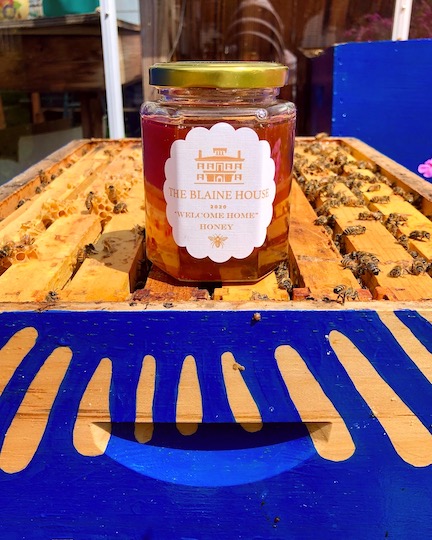
Honey harvested from the Blaine House hives in July 2020. Photo courtesy of Keepers
In addition to keeping hives for customers, Raasch also produces honey for sale from 10 or so hives that she keeps on friends’ and family’s land ranging from South Portland to Brunswick. She bottles each hive’s extraction separately and sells her “single source” honey in small batches on her website. “Honey is a floral snapshot of a very specific time and place,” she says.
Raasch has plans to scale up her apiary and grow Keepers’ clientele. She was recently accepted into the 2021 cohort of MOFGA’s Journeyperson Program and selected Erin MacGregor-Forbes as her mentor for the program. MacGregor-Forbes is a master beekeeper as well as the director of finance and administration at Maine Audubon. With her financial guidance, Raasch hopes to take a critical look at Keepers’ business model. “I can be more intentional about how it is structured,” says Raasch.
Raasch, who also teaches photography and experimental media at Maine College of Art (MECA), dreams of growing Keepers to her full-time job. She envisions buying farmland to house her apiary and the educational side of Keepers in one place (she currently offers classes at The Honey Exchange). Meanwhile, she continues to bring on new clients in Southern Maine. She notes that keeping bees in Maine’s cities is easier than one might expect. “Folks are planting a diversity of flora,” says Raasch. Portland also has a pesticide ordinance that restricts use of synthetic pesticides on private lawns and gardens and public property, including parks, athletic fields and playgrounds.
Urban hive management is also gratifying to Raasch from a public relations standpoint. Placing hives in public areas, like her high-profile worker bees at the Blaine House, offers an opportunity for Raasch to teach more people about the significance of the honeybee – whose continued legacy is really the bottom line of her business. The goal of Keepers is to grow a group of honeybee fans that will advocate on the pollinator’s behalf. Raasch says, “The stronger the health of our honeybee colonies, the stronger our ecosystems will be, the better our food systems will be, and the safer our children will grow up. It’s all interconnected in a way that is staggering, humbling.”
